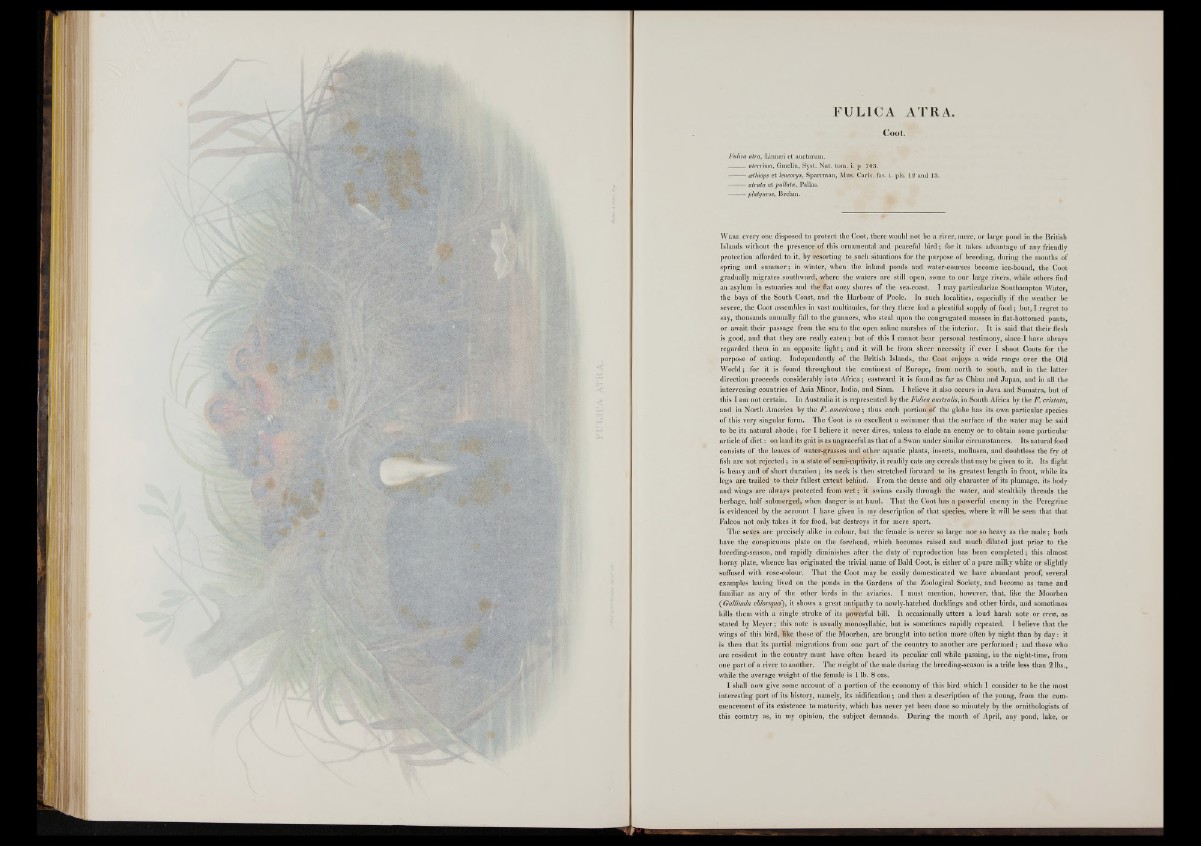
FULICA ATRA.
Coot.
Fúlica atra, Linnsei et auctorum.
, aterrima, Gmelin, Syst. Nat. tom. i. p. 703.
cethiops et leucoryx, Sparrman, Mus. Carls, fas. i. pis. 12 and 13.
—■— atrata et pullata, Pallas.
platyuros, Brehm.
Were every one disposed to protect the Coot, there would not be a river, mere, or large pond in the British
Islands without the presence of this ornamental and peaceful b ird ; for it takes advantage of any friendly
protection afforded to it, by resorting toifsuch situations for the purpose o f breeding, during the months of
spring and summer; in winter, when the inland ponds and water-courses become ice-bound, the Coot
gradually migrates southward, where the waters are still open, some to our large rivers, while others find
an asylum in estuaries and the flat oozy shores of the sea-coast. I may particularize Southampton Water,
the bays of the South Coast, and the Harbour of Poole. In such localities, especially if the weather be
severe, the Coot assembles in vast multitudes, for they there find a plentiful supply of food; but, I regret to
say, thousands annually fall to the gunners, who steal upon the congregated masses in flat-bottomed punts,
or await their passage from the sea to the open saline marshes of the interior. It is said that their flesh
is good, and that they are really e a ten ; but o f this I cannot bear personal testimony, since I have always
regarded them in au opposite lig h t; and it will be from sheer necessity if ever I shoot Coots for the
purpose o f eating. Independently of the British Islands, the Coot enjoys a wide range over the Old
W o rld ; for it is found throughout the continent o f Europe, from north to south, and in the latter
direction proceeds considerably into Africa; eastward it is found as far as China and Japan, and in all the
intervening countries o f Asia Minor, India, and Siam. I believe it also occurs in Java and Sumatra, but of
this I am not certain. In Australia it is represented by the Fulica australis, in South Africa by the F. cristata,
and in North America by the F. americana; thus each portion-cf the globe has its own particular species
of this very singular form. The Coot is so excellent a swimmer that the surface o f the water may be said
to be its natural abode; for I believe it never dives, unless to elude an enemy o r to obtain some particular
article of d ie t: on land its gait is as ungraceful as that o f a Swan under similar circumstances-. Its natural food
consists of the leaves of water-grasses and other aquatic plants, insects, mollusca, and doubtless the fry of
fish are not rejected; in a state o f semi-captivity, it readily eats any cereals that may be given to it. Its flight
is heavy and of short duration; its neck is then stretched forward to its greatest length in front, while its
legs are trailed to their fullest extent behind. From the dense and oily character o f its plumage, its body
and wings are always protected from w e t; it swims easily through the water, and stealthily threads the
herbage, half submerged, when danger is a t hand. That the Coot has a powerful enemy in the Peregrine
is evidenced by the account I have given in my description of that species, where it will be seen that that
Falcon not only takes it for food, but destroys it for mere sport.
The sexes are precisely alike in colour, but the female is never so large nor so heavy as the male; both
have the conspicuous plate on the forehead, which becomes raised and much dilated ju st prior to the
breeding-season, and rapidly diminishes after the duty of reproduction has been completed; this almost
horny plate, whence has originated the trivial name of Bald Coot, is either of a pure milky white o r slightly
suffused with rose-colour. That the Coot may be easily domesticated we have abundant proof, several
examples having lived on the ponds in the Gardens of the Zoological Society, and become as tame and
familiar as any o f the other birds in the aviaries. I must mention, however, that, like the Moorhen
(Gattinula chloropus), it shows a great antipathy to newly-hatched ducklings and other birds, and sometimes
kills them with a single stroke of its powerful bill. I t occasionally utters a loud harsh note or crew, as
stated by Meyer; this note is usually monosyllabic, but is sometimes rapidly repeated. I believe that the
wings of this bird, like those of the Moorhen, are brought into action more often by night than by d ay : it
is then that its partial migrations from one p art of the country to another are performed; and those who
are resident in the country must have often heard its peculiar call while passing, in the night-time, from
one p art o f a river to another. The weight o f the male during the breeding-season is a trifle less than 2 lbs.,
while the average weight of the female is 1 lb. 8 ozs.
I shall now give some account of a portion of the economy of this bird which I consider to be the most
interesting p art of its history, namely, its nidification; and then a description of the young, from the commencement
of its existence to maturity, which has never yet been done so minutely by the ornithologists of
this country as, iu my opinion, the subject demands. During the month of April, any pond, lake, or